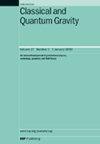Gravitational wave signal prediction technique based on advanced seasonal-trend decomposition using Loess
IF 3.6
3区 物理与天体物理
Q2 ASTRONOMY & ASTROPHYSICS
引用次数: 0
Abstract
Gravitational wave (GW) analysis is attracting widespread attention as an emerging research field. As the presence of substantial noise in GW signals, and the characteristics of inspiral and merger stage are different, coupled with the sidelobe effect caused by window length, traditional time–frequency analysis methods face significant challenges in accurately analyzing the frequency variations of GW signals. This poses a major limitation in the precise analysis stage following GW detection. Therefore, we proposed a novel method of seasonal-trend decomposition using Loess with multilayer perceptron (STLMLP), for predicting and validating the accuracy and effectiveness of GW frequency variations. Experiment results on three noiseless GW templates demonstrate that STLMLP exhibits the adaptability and highest prediction accuracy for the dynamic frequency variations of GW signals compared to five state-of-the-art machine learning and deep learning methods. Furthermore, experiments conducted on three noisy actual GW data compared with the state-of-the-art method of Fourier-based synchrosqueezing transform in the signal processing domain confirm that STLMLP maintains lower error in predicting frequency change over the whole duration of the actual noisy GW signals.基于黄土超前季节趋势分解的引力波信号预测技术
引力波分析作为一门新兴的研究领域正受到广泛关注。由于GW信号中存在大量噪声,且吸气和并合阶段的特性不同,再加上窗长引起的旁瓣效应,传统时频分析方法在准确分析GW信号频率变化时面临很大挑战。这对GW检测后的精确分析阶段构成了主要限制。因此,我们提出了一种基于多层感知器(STLMLP)的黄土季节趋势分解方法,用于预测和验证GW频率变化的准确性和有效性。实验结果表明,与五种最先进的机器学习和深度学习方法相比,STLMLP对GW信号的动态频率变化具有较高的适应性和预测精度。此外,在三个有噪声的实际GW数据上进行的实验与信号处理领域最先进的基于傅里叶的同步压缩变换方法进行了比较,证实了STLMLP在实际有噪声GW信号的整个持续时间内预测频率变化的误差较低。
本文章由计算机程序翻译,如有差异,请以英文原文为准。
求助全文
约1分钟内获得全文
求助全文
来源期刊

Classical and Quantum Gravity
物理-天文与天体物理
CiteScore
7.00
自引率
8.60%
发文量
301
审稿时长
2-4 weeks
期刊介绍:
Classical and Quantum Gravity is an established journal for physicists, mathematicians and cosmologists in the fields of gravitation and the theory of spacetime. The journal is now the acknowledged world leader in classical relativity and all areas of quantum gravity.
 求助内容:
求助内容: 应助结果提醒方式:
应助结果提醒方式:


